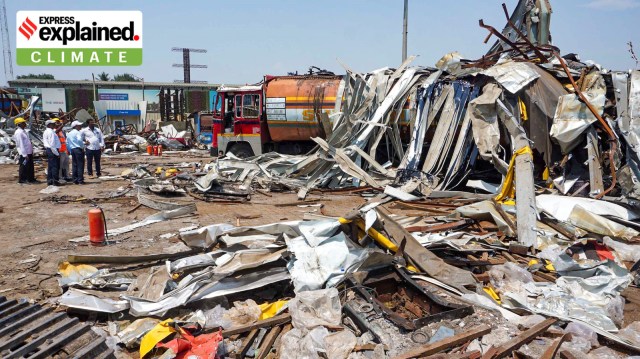An award-winning journalist with 14 years of experience, Nikhil Ghanekar is an Assistant Editor with the National Bureau [Government] of The Indian Express in New Delhi. He primarily covers environmental policy matters which involve tracking key decisions and inner workings of the Ministry of Environment, Forest and Climate Change. He also covers the functioning of the National Green Tribunal and writes on the impact of environmental policies on wildlife conservation, forestry issues and climate change. Nikhil joined The Indian Express in 2024. Originally from Mumbai, he has worked in publications such as Tehelka, Hindustan Times, DNA Newspaper, News18 and Indiaspend. In the past 14 years, he has written on a range of subjects such as sports, current affairs, civic issues, city centric environment news, central government policies and politics. ... Read More
Mumbai billboard collapse: Why cities need to gear up for ‘multi-hazard weather events’
With rising global temperatures, countries, including India, are witnessing more intense and frequent thunderstorms as at warmer temperatures, the atmosphere can hold more water vapour
 Officials inspect the site after a billboard fell on May 13 due to rains and dust storm, in Ghatkopar area of Mumbai, Thursday, May 16, 2024. (PTI photo)
Officials inspect the site after a billboard fell on May 13 due to rains and dust storm, in Ghatkopar area of Mumbai, Thursday, May 16, 2024. (PTI photo)Earlier this week, a massive billboard collapsed, killing 16 people and injuring more than 75, due to a localised dust storm and rain in several parts of Mumbai.
Although events such as localised dust storms, thunderstorms, hailstorms and extreme rainfall — also known as multi-hazard weather events — are not uncommon, local governance bodies do not plan for them on the same scale as larger disasters. The latest incident in Mumbai has highlighted the severe implications local weather events can have on human life and property, especially in densely populated cities.
Here is a look at such events and their impact.
But first, what happened in Mumbai?
On May 13, Mumbai experienced a pre-monsoon thunderstorm between 3 pm and 4 pm. The event began with a dust storm and was followed by rain that took place in the city and suburban areas. The wind speeds ranged from 40 kmph to 90 kmph, varying from place to place. The India Meteorological Department’s (IMD) Santacruz and Colaba weather stations recorded a top wind speed of 87 kmph and 51 kmph, respectively.
The winds damaged railway infrastructure, banners, hoardings, and trees at different locations. They also led to the collapse of a massive 120×120 feet billboard in Ghatkopar (east), resulting in the deaths and injuries of numerous people.
How do thunderstorms develop and are they becoming more intense?
Thunderstorms and dust storms are natural weather phenomena and occur during peak summer and pre-monsoon periods. Persistent surface heating and favourable wind conditions combine to form thunderstorms.
“Thunderstorms are mesoscale (at a smaller scale), localised events which can cause a lot of damage due to the strong winds that accompany them. Dust storms can also cause damage. Thunderstorms form during later afternoons and evenings, form quickly and die down soon,” said M Rajeevan Nair, former secretary, Ministry of Earth Sciences.
With rising global temperatures, countries, including India, are witnessing more intense and frequent thunderstorms as at warmer temperatures, the atmosphere can hold more water vapour, according to Nair.
Sunil Kamble, director, regional meteorological centre, India Meteorological Department (IMD), Mumbai said that IMD issues impact-based forecasts for weather events like thunderstorms and heavy rain spells. “We issue advance forecasts and nowcasts too. We also share the forecasts with the city’s disaster department, airport and railways so that action can be taken at the ground-level,” said Kamble.
What are climate and weather-related hazards?
Meteorological events that can cause extensive damage to human life, properties, and animals are broadly categorised as climate or weather-related hazards. In 2022, the IMD prepared an atlas of 13 such hazards – dust storms, thunderstorms, hailstorms, cyclones, drought, extreme rainfall events, floods, fog, lightning, snowfall, heatwave, coldwave, and strong winds. This atlas mapped the vulnerability of districts to these climate hazards based on disaster data, climatological archives, population, and housing density.
These events can also be categorised as multi-hazard events as they can cause fatalities, displacement, property damage, livestock deaths, crop damage as well as widespread damage to infrastructure.
Lubaina Rangwala, Program Head, Urban Development, World Resources Institute said the Mumbai episode highlights the need for climate-proofing infrastructure in big cities.
Rangwala said a lot of focus in Mumbai is on urban flooding. But being a coastal city, it will keep facing different kinds of risks, including multi-hazard events. “We need climate-proofing of infrastructure to withstand multi-hazard events. The billboard accident showed that it was not able to withstand high wind speeds. You cannot have objects that can potentially fall or projectile onto people in such a congested city. Authorities need to review this kind of infrastructure”.
What is the impact of such events on human life?
The National Crime Records Bureau (NCRB) 2022 report on accidental deaths and suicides in India revealed that in 2021, there were 8,060 accidental deaths in India due to ‘forces of nature’ such as lightning, heat stroke, exposure to cold, floods, landslides and torrential rains.
Lightning led to the most number of deaths, accounting for 35.8% of more than 8,000 deaths by natural events. In terms of absolute numbers, lightning strikes killed 2,887 people, floods killed 547 people, landslides killed 269 people, exposure to cold killed 720 people and heat stroke killed 730 people.







































